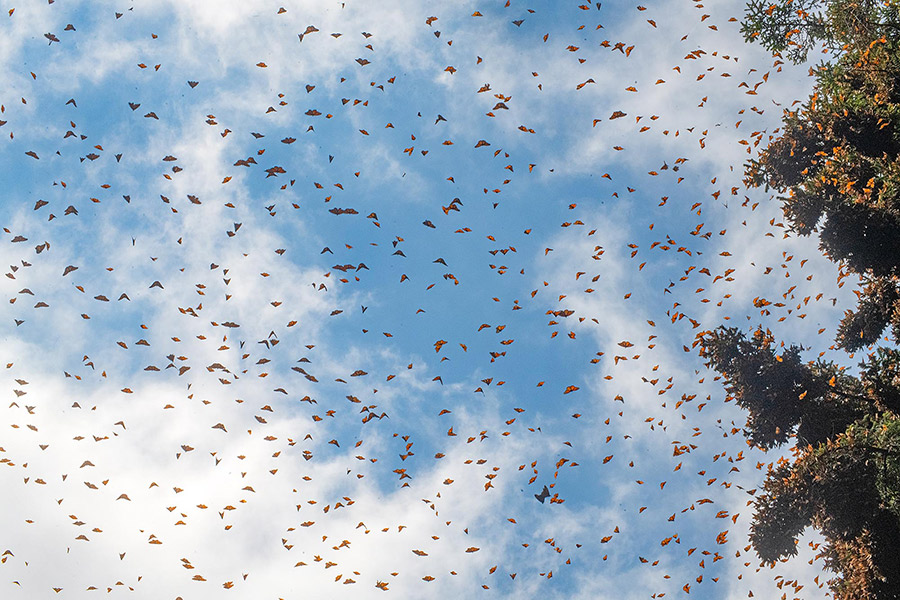Gorgeous natural beauty today from a part of the world known for hosting millions of butterflies during their annual migration to the Monarch Butterfly Biosphere Reserve in Mexico, where millions of monarchs gather each year to overwinter in the oyamel fir forests, primarily in the state of Michoacán. Street artist, muralist, biologist, and entomologist, Mantra has traveled to this region several times to study the butterflies, and this year he invited photographer Martha Cooper to witness this annual event and to see him paint in local towns like Zitabcuaro, Cerro Prieto, El Rosario, and Sierra Chincua.

The monarch butterfly migration usually begins in late August and lasts until early November, bringing butterflies from Canada and the United States. The purpose of the sanctuary is to protect the monarch’s habitat and promote conservation efforts to ensure their survival. The Mexican government and local communities manage the sanctuary, which reports as many as 200,000 human visitors annually.

Various local, regional, and federal authorities work together to protect the forest and educate visitors about preserving the monarch butterfly. Towns and farmers, even religious organizations, have embraced the monarch butterfly as a symbol of hope and renewal, and they have incorporated it into their art, music, and festivals.
We are thankful to Mantra, Martha, and cousin Sally for taking this trip to see these scenes just days before they began their migration northward again in March to places like the Great Lakes region of the United States and Canada, where the butterflies will stop to refuel and reproduce, as well as parts of the southern United States and Mexico where they breed and lay eggs before continuing their journey northward.







In the Ejido Cierro Prieto community, located in the state of Michoacán, the Bio-Cultural Festival of the Monarch Butterfly brings together community, conservation organizations, and visitors from everywhere to celebrate. Martha and Sally caught the “Danza de los Tecuanes,” or the Dance of the Jaguars. This dance is performed in many indigenous communities in Mexico and involves dancers wearing elaborate costumes and masks depicting jaguars and other animals.

The dance is accompanied by live music played on traditional instruments, such as drums and rattles, and it incorporates elements of storytelling and ritual. The sword clashes are said to represent the jaguars’ fierce and robust nature, as well as their role as protectors of the forest and its inhabitants. The dance symbolizes the community’s connection to the natural world and its commitment to preserving the monarch butterfly’s habitat and other vital ecosystems.

















Other Articles You May Like from BSA:
That charming GEICO gecko looks like he’s darned fed-up with the highway police in Memphis, Tennessee. Why else is he telling drivers to defund them? Indecline. Memphis, TN. October 5th, 2021. (ph...
Turin, Italy remains a hotbed for free thought and experimental art in public spaces. Despite so many inroads toward capitalizing on the radical movement of street art in recent years, this part of I...
Welcome to BSA Images of the Week. The streets are reflecting this moment in New York this week as artists are showing their colors. Or Ukraine's colors, rather. Hard to sleep through the night w...
Mexican street artist Said Dokins clearly loves towers to create his work upon. And he adores covering them with all sorts of cryptic symbols and stylized letter forms. Now we find him doing a decided...
Banksy's "The Girl With A Pierced Eardrum" painted in Bristol's Albion Dock in 2019 has experienced a Covid-19 makeover. Banksy "The Girl with a Pierced Eardrum" Bristol, UK. (photo © Reuters/Reb...
 BROOKLYN STREET ART LOVES YOU MORE EVERY DAY
BROOKLYN STREET ART LOVES YOU MORE EVERY DAY










